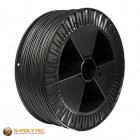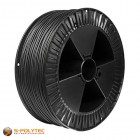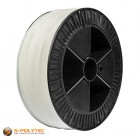
Welding wires & welding rods for polyethylene
Our welding wires and welding rods made of high-quality polyethylene for the welding of PE plastics are available in different shapes, colors and thicknesses and are available by the meter at favorable graduated prices. Excellent quality - Made in Germany!
- We supply our PE welding wires and PE welding rods starting from 1 meter purchase quantity
- Buy our welding wires and welding rods made of polyethylene at affordable graduated prices
- We offer PE welding wires and rods in different diameters, shapes and colors
- We guarantee the highest quality for perfect welds with our PE welding wires
PE-HD Welding Rod Black 3mm
 from €0.42 / m
from €0.42 / mIncl. 19% Tax
PE-HD Welding Rod Black 4mm
 from €0.44 / m
from €0.44 / mIncl. 19% Tax
PE-HD welding rod nature 4mm
 from €0.44 / m
from €0.44 / mIncl. 19% Tax
Welding rods and wires made of polyethylene
Polyethylene is one of the low-energy plastics that cannot be bonded without a special PE adhesive. Depending on the application, bonding can also be ruled out, as the few suitable adhesives can often also affect the areas of application, so that contact with foodstuffs, for example, may no longer be permissible. With plastic welding of polyethylene, on the other hand, the plastics to be joined are fused together with a plastic wire of the same type, the so-called welding wire, through the action of heat, without this having any effect on the general properties of the plastic or restrictions in its areas of application having to be feared.
Welding rod or welding wire
The decision whether to use a welding rod or a welding wire depends primarily on the welding method used, because depending on the welding equipment, it may be necessary to use a welding wire to ensure permanent and gap-free tracking of the welding wire. For this reason, most welding rods in round are also offered in rolls and more special shapes such as oval welding rods or welding rods in triangular design, are usually offered as rods with a length of one or two metres. Furthermore, this means that the choice whether wire or rod also depends on the design, shape, colour and/or thickness in which it is available.
Physical characteristics of our polyethylene welding rods and wires
Our PE welding rods and welding rods are made of single-grade polyethylene and therefore have the same properties as our solid polyethylene plastic sheets. The physical density of the welding rods for PE-HD is 0.96 g/cm3. The density of welding rods for PE-HMW or PE500 is only slightly lower at 0.95 g/cm3 and the density of welding rods for electrically conductive PE is 0.99 g/cm3, which is slightly higher than the density of conventional PE-HD. As is usual for polyethylene, the PE welding rods are also considered normally combustible and meet the fire protection standard DIN 4102 B2.
How is polyethylene welded?
The right welding rod for polyethylene
Especially when welding polyethylene, the choice of the right plastic welding rod is very important, because a suitable PE-HD welding rod is required for welding PE-HD. For welding PE-HMW (PE-500), on the other hand, a PE-HMW welding rod should be used in order to achieve a safe and durable weld.
The correct welding temperature for polyethylene
When choosing the welding temperature, there are no special settings to be observed for the different polyethylene types, so that with all welding wires made of PE they achieve best results when welding the plastic sheets made of polyethylene in a temperature range between +220 °C and +280 °C. If the temperature is too low, neither the surfaces to be welded nor the welding wire itself will be heated sufficiently, so that fusion cannot be guaranteed. If, on the other hand, the temperature is set too high, this causes the plastic to burn, which affects the quality of the weld seam and, in the worst case, means that the parts to be welded can no longer be used without the burnt material having to be removed.
Preparation for welding polyethelyne
As with all plastics, the surface must be stripped with a sharp object, for example a cutter knife or a deburrer, before plastic welding to remove the oxide layer that can form on the surfaces over time. This ensures that the weld is not negatively affected by the oxide layer.
Reworking the polyethylene weld seam
As soon as the weld seam has cooled down, it can either be strengthened by applying another weld seam or it can be planned or sanded to achieve an even appearance of the joint. Particularly in the case of welded containers that are to contain dust or liquids, the weld seam should be checked for tightness and, if necessary, repaired if leaks occur. This can be done by a repeated welding process.
Our delivery programme for polyethylene welding wires and rods
- PE welding wires for PE-HD in natural colour in various thicknesses and designs
- PE welding wires for PE-HD in the colour black in various thicknesses and designs
- PE welding wires for PE-HMW in natural colour in various thicknesses and designs
- PE welding rods for PE-HD in the colour black in various thicknesses and designs
On request we also supply
- PE welding wires for PE-HD in the colour light blue in various thicknesses and designs
- PE welding rods for PE-HD in natural colour in various thicknesses in round design
- PE welding wires for PE-EL in black in various thicknesses in round design
Areas of application for welding polyethylene
Polyethylene cannot be bonded without special adhesives, such as our S-Polybond PEprofi, which is why welding this plastic is common practice to create a permanent and secure joint. In particular, plastic sheets made of PE are welded when manufacturing containers for the food industry, waste disposal or even for the safe transport of chemicals. Plastic welding is also a widely used method for repairing cracks and leaks in polyethylene containers and tubs.
Disposal of PE welding wires and PE welding rods
Welding rods and welding rods made of polyethylene can be easily disposed of in the recycling bag or the recycling bin. Alternatively, this plastic can be ground into excellent regranulate, provided that it is separated by type, so that it can later be used in the recycling process to produce plastic sheets or welding rods from polyethylene regrind.